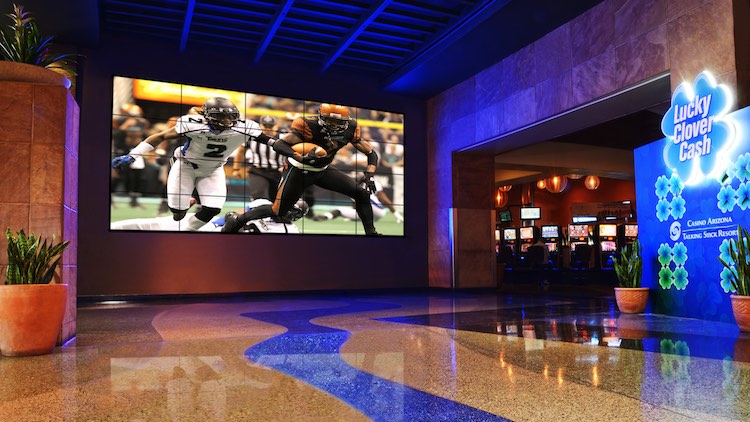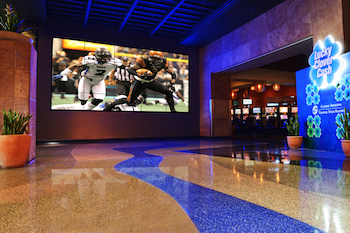Tech That Takes Guest Experiences Up a Notch


A 4x5 video wall, installed by CCS, greets visitors at Casino Arizona. You arrive at your hotel, strolling through the front entrance, or perhaps, the casino. You may be tired after a long flight, or after an even longer day of meetings. Maybe you’re at the start of a brief getaway, a little adventure in a new spot.
You pull out your wallet as you approach reception to check in. Then it hits you: a lobby replete with a video wall, lots of digital signage, and engaging content to let you know where everything is at your destination—from the pool to the bistro, to the surrounding properties. You relax.
“What we see is that a lot of hotels are putting in the ‘wow’ factor tech in the lobby area, behind the check-in desk; a video wall displaying various aspects of the property from the pool or bar, with more displays in the bar featuring sporting events and other entertainment,” said Joseph Yost, director of integration, CCS Presentation Systems, number six on SCN’s 2017 Top 50 Integrators. “This hospitality market is growing as the tech becomes more affordable and mainstream.”
Hospitality clients are trying to differentiate their brands in the marketplace by setting the mood with AV technology, noted Josh Hoffert, director of professional services, Alpha Video & Audio, 42 on SCN’s Top 50 Integrators list. “We see more and more of that in the hotel side of casinos, with the ambiance factor making a big presence as soon as guests walk in. We’ve seen, in the last three or four years, more virtual concierge features by way of interactive screens.”
This is evident, he said, particularly with larger, mid- to upper-scale hotel brands. The goal is to reflect the brand’s particular style by way of creative art walls. “I’ve seen art walls that reflect the environment or region as well as those that reinforce tribal lore for Native American properties. Some are crazy ambitious, over-the-top walls that are thought provoking.”
Layouts, too, have become more elaborate. “They’re not all your square or rectangular walls anymore,” Hoffert said. “These are designed to be much more eye-catching.”
In hotel rooms themselves, the higher-end suites are also being treated to the newer AV experiences. “We have partnerships with certain providers in cable and they have some great technology,” he added. “One is Enseo, in-room entertainment solutions, to bring Netflix, Hulu, and Pandora, etc. directly into the guest TV, melding with the guest’s own device. Other widgets or info apps can be pulled up, customized to book a spa session, for example.”
A daily selection of the top stories for AV integrators, resellers and consultants. Sign up below.
With other companies providing similar systems, Hoffert said this technology will be offered throughout many hotel brands in the near future.
Age Matters
Not surprisingly, employee age plays a role in operating hospitality AV, Yost said. “Millennials are coming into the hospitality workforce, and in contrast to a lot of older, upper management staff, have been brought up with technology, and they want and expect to implement it. Hotels and the whole hospitality industry are catching onto this. With digital signage and networking costs coming down, it’s more affordable to install more technology in a property. From one central location, I can promote a property to several different areas by using one marketing employee to create content and push it out.”
Even younger systems operators are getting into the hospitality AV scene. At the Grand Canyon University Hotel and Restaurant, where the backbone is a SDSI video-over-IP system with a Crestron control system, the wow factor is a hotel check in with a restaurant/sports bar. “What makes it unique,” he noted, “is that it's run by students from Grand Canyon University, and each student is in the hospitality program. It’s a fully functional hotel restaurant and sports bar but a classroom at the same time. We also did their golf course clubhouse.”

Digital signage aims to upsell tickets at Clearwater Casino. Integration was completed by Alpha Video & Audio. In brand-name hotels, the AV technology is not only in lobby digital signage but behind hotel bars with refrigerators that are themselves clear displays, promoting a favorite beverage or a certain drink, or menu offerings. “And if a vendor wants to place a product in a hotel, they may be asked to pay for advertising it, the way a grocery store is paid for endcap product placement,” Yost said. “A restaurant can be advertised on the hotel’s digital signage for a monthly fee.”
There’s no city that capitalizes better on product placement advertising than Las Vegas, which also happens to be a world leader in high-end hospitality. “I see it throughout Vegas,” Yost said, “and if you walk into any of the hotel malls you see the digital signage all over the place with ads for products sold in their shops. If you want to see what hospitality is doing with AV, Vegas is the place. You can be a middle-class citizen and be treated like gold. The way they keep properties, and the cleanliness is just first class. They utilize technology to the max—from marquees on the street to sports books—and the display info put out is up-to-date with technology. An example is Westgate Las Vegas Resort & Casino (formerly the LVH); their sports book (SuperBook) contains the world’s largest indoor LED video wall.”
Elsewhere, one of CCS’s customers, an engineering firm, is talking about getting one of their own customers to sponsor part of the digital signage in the firm’s headquarters. “That’s new,” he explained. “We brought it up to them and told them if they were worried about the price of signage for their headquarters, they should propose that one of their customers sponsor part of it because all of the engineering firm’s employees use the customer’s products. This is a true partnership between all the entities.”
Don’t Forget to Upsell
Like other markets, hospitality includes opportunities for upgrades. “We’re working with a Native American casino project upgrade in Scottsdale where we’ve had multiple video walls in there for years and will be changing them out to newer technology,” Yost said. “It’s getting easier for us to transport video over networks so we find we don't have to create many different disciplines, just create VLANs. The AV industry has adopted networking principles; a lot of hospitality properties already have networks in place. We can transport video, audio, and actually send audio from one property to another to lower costs. So, smaller properties can now afford more technology, and although direct-view LED is still unattainable, that will come down [in price] as we’ve already seen.”
As more and more properties implement large-format touchscreens, try offering virtual concierge experiences to help those businesses become more guest friendly, Hoffert said. “In the hotel convention centers, clients are looking for additional automation. You can walk through a hotel and see a piece of paper with a schedule of events and meetings; this requires labor. Now, we’re seeing small-format displays of 32 inches or smaller that auto read the data and keep information relevant. And integration of digital menu boards, touch or non-touch, allows for easier updates.”
This can all be tied into the point-of-sales system living in the hotel’s restaurant, for example, with descriptions of what’s offered. “A full option is touch, interactive systems,” he said. “And there’s more coming. I’ve been told that when you go to a McDonald’s in Japan they know who you are. It’s crazy; we’re playing with some fun stuff.”
